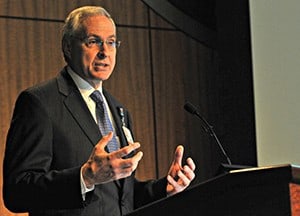UAMS Sees Significant Clinical Growth, Looks Ahead
| Feb. 12, 2015 | As the health care industry changes “in real time,” UAMS is aimed at strategies to deliver better care, better patient experience and lower costs, said UAMS Chancellor Dan Rahn, M.D., during his annual State of the University presentation Feb. 10.
UAMS reported significant increases in patient volume and a dramatic reduction in uncompensated medical care in the past year, he said. The chancellor also highlighted many successes in the institution’s academic and research areas, despite slowing federal funding for research.

UAMS Chancellor Dan Rahn, M.D., delivers the annual State of the University address Feb. 10.
“UAMS like many other academic medical centers is dependent on patient care revenue,” Rahn said, noting that in current fiscal year 2015, clinical operations accounted for 75 percent of UAMS revenue. “It has been robust growth in patient care revenue in the past that has allowed academic medical centers to grow, and that has plateaued.
“We are more dependent on patient care revenue than ever before because of cuts we have experienced in other funding streams.”
The chancellor covered some of the highlights across UAMS, evidence of the institution working toward its mission of statewide health and health care improvement. He also discussed how the state’s only academic health sciences center was making changes in how it delivers care to better meet health care demands.+
Among the many highlights:
- Total student enrollment has grown to 2,890 across 73 degree and certificate programs — including five-year enrollment growth of 10 percent in the College of Medicine and nearly 20 percent in the Graduate School
- Research funding — which has been flat or decreased in recent years largely due to cuts in federal research funding — increased by about $5 million between fiscal years 2013-2014.
- One measure of research productivity that has not slowed — publication by UAMS scientists of their work in peer-reviewed journals,
 which has increased 71 percent in 11 years to more than 1,200 articles in 2014.
which has increased 71 percent in 11 years to more than 1,200 articles in 2014. - Clinical patient volume has increased, with increases of 14.7 percent in outpatient visits, 15.2 percent in surgical cases and 5.7 percent in hospital inpatient visits from the current fiscal year 2015 to date compared to the same period in the previous fiscal year.
- Patient volume in the six family medicine clinics at the UAMS regional locations around the state are rising 10 percent this fiscal year compared to the same period last year.
- Expanded insurance coverage through health care reform and the state’s “private option” has reduced the number of uninsured patients from 13 percent last year to 3 percent.
Rahn said expanded insurance coverage was a factor in the significant patient volume increase, but not the only factor. He also credited improvements in patient services and clinic access.
To expand access to clinical care, UAMS in 2014 opened its Rahling Road Neighborhood Clinic — its second in west Little Rock with more planned in other areas. UAMS also has made “significant” clinic improvements in its Regional Programs locations around the state to accommodate more patients, he said.
Even with the expansions, there are capacity issues. Hospital beds are routinely full — “Just about every morning we have no beds available,” he said.
“A key reason for our improved financial performance and our strategic alignment is the work that has been done by UAMS employees,” he said. “You have taken our challenges head on by looking for ways to be more efficient and improve processes through a university-wide, employee-led performance improvement initiative, Performance Excellence that has helped achieve savings of about $1.5 million.”
The strategic alignment of clinical programs into service lines — a model for care that organizes all services around the patient in the most efficient and patient-centered way possible — is accelerating. The first four redesigned service lines, in women’s health, cancer, primary care and behavioral health are expected to be completely integrated by July 1.
These changes and other ongoing efforts across UAMS — whether its creation of more interprofessional education opportunities, new programs in physical therapy or dental care or centralization some services — all can be tied to goals set in the UAMS 2020 Strategic Plan adopted in 2010.
“Our goals are to create a patient-centered care environment; educate culturally competent health professionals; continue the development and expansion of multi-disciplinary research programs; and develop research, educational and technical assistance expertise in population health strategies,” he said. “We’re not just here for the practice of medicine, we are here to lead toward better health across all sectors and to support our talent-rich environment at UAMS.”